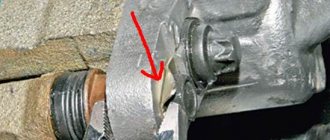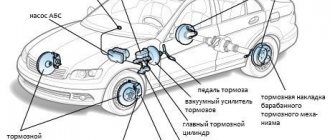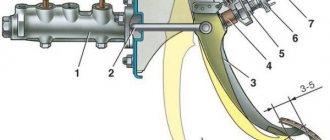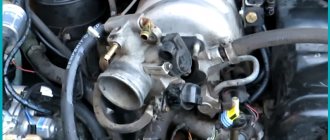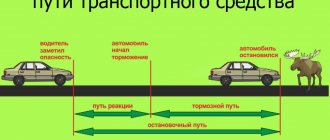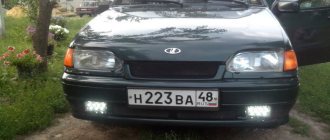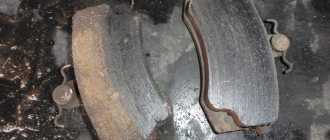Concept of car braking distance
Even if a professional driver is driving a car, a situation may always arise on the road when it is necessary to stop the vehicle as quickly as possible:
- sudden appearance of a person or animal on the road;
- vehicle malfunction;
- violation of traffic rules by another driver, which leads to the creation of an emergency situation;
- unforeseen circumstances: uneven road surface, obstacle (fallen tree, stone), etc.
To stop the car, the driver uses the brake pedal, activating its braking system.
The braking distance of a car is the distance covered by the vehicle during the period of time from the moment the braking system is activated until the vehicle reaches a speed of 0 km/h.
Determining vehicle speed by braking distance
The stopping distance is usually understood as the distance covered by a vehicle from the start of braking (or, to be more precise, from the moment the braking system is activated) to a complete stop. The general, non-detailed formula from which it is possible to derive a formula for calculating speed looks like this:
Va = 0.5 x t3 x j + √2Syu x j = 0.5 0.3 5 + √2 x 21 x 5 = 0.75 +14.49 = 15.24 m/s = 54.9 km/h where: in the expression √2Sу x j, where:
Va is the initial speed of the car, measured in meters per second;
t3 – vehicle deceleration rise time in seconds;
j – steady deceleration of the vehicle during braking, m/s2; Please note that for a wet coating - 5 m/s2 according to GOST 25478-91, and for a dry coating j = 6.8 m/s2, hence the initial speed of the car at a “skid” of 21 meters is 17.92 m/s, or 64 .5km/h.
Syu is the length of the brake track (skid), also measured in meters.
Based on the above equation, we can conclude that the braking distance is affected primarily by the speed of the car, which, if the other values are known, is not difficult to calculate. The most difficult part of the calculations using this formula is the exact determination of the friction coefficient, since its value is influenced by a number of factors:
- type of road surface;
- weather conditions (when the surface is wetted with water, the friction coefficient decreases);
- tire type;
- tire condition.
For an accurate calculation result, you also need to take into account the features of the braking system of a particular vehicle, for example:
- material and quality of brake pads;
- diameter of brake discs;
- functioning or malfunction of electronic devices that control the braking system.
Brake track
After a fairly quick activation of the brake system, imprints remain on the road surface - brake marks. If the wheel is completely blocked during braking and does not rotate, continuous marks remain (sometimes called “skid marks”), which many authors call for to be considered a consequence of pressing the brake pedal as hard as possible (“brake to the floor”). In the case when the pedal is not fully pressed (or there is some defect in the braking system), “smeared” tread marks remain on the road surface, which are formed due to incomplete blocking of the wheels, which, during such braking, retain the ability to rotate.
Stopping path
The stopping distance is considered to be the distance that a certain vehicle travels from the moment the driver detects a threat until the vehicle stops. This is precisely the main difference between the braking distance and the stopping distance - the latter includes both the distance that the car covered during the time the braking system was activated, and the distance that was covered during the time it took the driver to realize the danger and react to it. The driver's reaction time is influenced by the following factors:
- driver's body position;
- psycho-emotional state of the driver;
- fatigue;
- some diseases;
- alcohol or drug intoxication.
P O P U L A R N O E:
- Printer utility program - PrintHelp
The SuperPrint development team (Resetters) created the program
PrintHelp
for servicing Epson inkjet printers.
This program replaced SPUA, which performed only one function - resetting the diaper usage counter.
Read more…
Free, simple program - Xleaner
How to quickly clean your system of unnecessary junk? How to optimize the system?
A simple free program will help you with this - Xleaner .
If your computer starts to slow down and takes a long time to boot, then you need to “clean your computer” of unnecessary “garbage”. Using the Xleaner program, this can be done by anyone, even a PC user who has little understanding of this matter.
Read more…
Charger with automatic disconnection from the network
Another charger circuit is very similar to the previous one, but differs in the way it turns off when charging is complete. The charger is started by pressing the “start” button on the front panel, while the supply voltage is supplied to the circuit, relay K1 is activated and provides “self-recovery”. Read more…
Popularity: 1,570 views.
Formulas for calculating stopping and braking distances, as well as safe distances.
In the theory exam there is a question about the average reaction time of a driver, the correct answer to which is 1 second. The traffic police tickets also contain a question related to safe distance. There are questions regarding braking. But, as they say, a theory is a theory, which, alas, as a rule, has nothing in common with practice.
Firstly, what you taught in the tickets is a theory based on averages and various studies. In fact, the driver's reaction time, stopping and braking distance depend on many factors and cannot be accurately calculated for all cases. Nevertheless, every driver should be able to calculate these parameters at least approximately.
How will this help in practice?
In the meantime, here is the practical meaning of this article.
Use quality tires
Remember, a car slows down not with brakes, but with tires. If your tires are worn out, cheap, or just out of season, your car will not brake well and won't benefit from good brakes. If you want to increase safety and improve the braking dynamics of your car, you don’t need to tune the brakes and install expensive brake discs, pads, etc. Install expensive, high-quality tires, and then your driving life will be safer.
Car tuning requires a professional approach
If you decide to “put” your car on super grippy tires - either for racing or for your own safety, keep in mind that this is already an intervention in the design of the car, tuning
You can't do it with tires alone - they will require powerful brakes, and choosing them and installing them correctly is an extremely important and difficult task. So take car tuning seriously and use the services of professionals, because such things do not tolerate amateur performances
A small, lightweight car offers no braking advantage.
When choosing a car when buying, do not think that a small city car will be safer compared to a minivan and especially a truck just because it is lighter and supposedly has better brakes. It doesn't brake any better, and even if it does better, the weight has nothing to do with it. Be careful if you drive a small car. Especially when you are driving behind a truck: do not approach it and do not think that if something happens it will stop for a long time, and you will certainly have time to stop... Maintain a safe distance, regardless of the difference in the weights of the vehicles.
Maintain composure while driving a busy car
If you have to travel in a car with passengers and a full trunk, be alert, but do not lose your composure when braking. Yes, it will seem to you that the braking has become worse. But this is only because you are used to a different force on the brake pedal. Press the brake harder than usual, and the car will slow down the way you need. But even after unloading the car, don’t lose your head - after all, the car will become more responsive to pressing the brake pedal, but this is an illusion: the braking distance will not become shorter!
Don't overload the machine
Each machine has its own purpose for use and its own permissible load. If it is exceeded, the tires and brakes may overheat, or even completely deteriorate. In any case, they will not cope with the braking task. The braking distance will increase noticeably, and this, as you understand, can lead to an accident.
Learn to brake properly
It would seem that what is so difficult here? But our coaching experience says that many drivers lack smoothness and knowledge of many subtleties in everyday braking and, conversely, lack sharpness in emergency braking. I wrote about this in general terms in the article “How to Brake Properly?” for the driver: Mastery of Driving a Car."
What is the braking distance formula?
In general, car braking is divided into two types. For example, there is normal braking, and there is emergency braking, when you need to suddenly stop the car to avoid an accident.
When braking in everyday life, for example, if you want to stop a car at a traffic light, you usually press the brake pedal much smoother and softer than if you need to completely stop the car in a parking lot. In this case, you are not applying maximum braking force to the car. With such smooth and soft braking, as a rule, the braking distance (braking distance) increases. The approximate stopping distance for normal braking can be calculated using the following simple formula:
(Speed in km/h: 10) x (speed in km/h: 10) = braking distance in meters
During emergency braking, the brake pedal is usually pressed fully and with full force. Due to the higher braking force, the stopping distance of the car is usually reduced by about 2 times. Therefore, the braking distance can also be calculated using the following formula:
(Speed in km/h : 10) x (speed in km/h : 10) / 2 = braking distance in meters
Attention: The braking distance calculated using these formulas is only an approximate value and a hint for drivers. In fact, in reality the braking distance can be either shorter or longer. After all, the braking distance depends on the driver’s driving skills and experience, the technical condition of the car, its design, make, model, road conditions, the condition of the tire tread and many other factors that directly affect the braking distance. But thanks to these formulas, you can approximately calculate the average braking distance of a car at a certain speed. This will allow you to adjust your driving style and will also be a good guide for novice drivers.
How to calculate the total stopping time and the final braking distance?
As we have already said, in order to calculate the entire braking distance, it is necessary to take into account the loss of time when the driver makes the decision to brake (that is, the driver’s reaction time). To do this, you need to use a different formula, which provides a more accurate approximate calculation of the braking distance that the car will travel at the moment the decision is made to stop. Here is the formula:
(Speed in km/h: 10) x 3 = reaction distance in meters
As a result, by making calculations using the above formulas, you can calculate the approximate final braking distance of your car at any speed. Here's an example. If you drive your car at a speed of 50 km/h, then using the given formulas calculate the following values:
Note: Please note that if the vehicle's speed is only twice as high, its final braking distance will increase by four times.
That is, the opinion that when the speed of a car doubles, the braking distance only doubles is a pure myth among many car enthusiasts. So keep this in mind when you get behind the wheel. The most surprising thing is that even many experienced drivers do not know about this.
Example of calculating braking and stopping distances
Source
What does braking distance depend on?
Obviously, the braking distance will vary depending on the situation and its conditions. Thus, factors influencing the magnitude of this path are divided into two groups:
- Factors that depend on the motorist.
- Factors that are beyond the control of the motorist.
Conditions that are independent of who is driving include weather and road surface conditions. As for the weather, it is logical that in rain, snow or ice it will take more time to stop the car than in dry weather.
The road surface also affects braking distance. If the road is smooth without adding stone, then the distance that the vehicle will travel when braking will also be greater.
On a note! If there are potholes on the roads, then most likely the braking distance will be short. This is due to the fact that on such a bad section of the road the driver simply will not reach high speed.
There are many more factors that depend on the driver (car owner):
- speed. Logically, the lower the speed, the shorter the braking distance;
- condition and design of the brake system. It is important that the car, including its brakes, works properly, that the pads are not worn out, and that the tire pressure is sufficient.
- type of tires installed. The tread should not be heavily worn, and the type of tire installed should be suitable for weather conditions;
- loading the car. The lighter the vehicle, the easier it is to stop it. The braking distance of a loaded vehicle will be longer;
- presence of ABS system. On dry asphalt, this system will help stop the car faster, but in icy conditions it will allow you to maintain control, but the braking distance will become longer;
- sober state of the driver. An adequate driver reacts faster to a rapidly changing situation on the road, thanks to which he will quickly stop his vehicle if necessary;
- absence of distractions while driving. Often, a motorist's slow reaction is due to the fact that he is distracted and does not watch the road. The most common distraction is the mobile phone. Due to the slower reaction of the person driving the car, the braking distance increases.
How to calculate the total stopping time and the final braking distance?
So, the final value of this path includes not only the braking distance, but also the driver’s reaction distance.
To calculate the distance a car will travel during the driver’s reaction time, you must use the following formula:
Sreaction = V / 10 * 3, where
V is the speed of the vehicle.
Thus, the final braking distance will be equal to the sum of two values: the driver’s reaction path and the braking distance:
Stotal = Storm + Sreactions
Returning to the example in which a car moves on dry asphalt in the summer at a speed of 80 km/h, let’s calculate the reaction distance.
Sreaction = 80/10 * 3 = 24 meters
Now that we know that the braking distance is 36 meters and the reaction distance is 24 meters, we can calculate its total value:
Stotal = 36 + 24 = 60 meters
Accordingly, the total stopping time is the time period during which the car will cover the final braking distance. This time is the sum of the driver's reaction time and the time spent on the braking distance.
The formula for calculating it is as follows:
, where: – driver reaction time; – time of operation of the brake drive; – time of increase in braking forces; – initial braking speed; - acceleration of gravity; – coefficient of longitudinal adhesion of the car wheels; – braking efficiency coefficient.
Important! The generally accepted standard for a motorist's reaction time is one second.
So, the final stopping distance includes the driver's reaction distance and braking distance. Each of these quantities is influenced by certain factors. To reduce the value of the final value, it is necessary to comply with the speed limit, monitor the serviceability of the car, take into account its load and drive only in adequate condition.
Braking distance formula
Let's consider the two most popular formulas:
1) S =V2/2μg.
Description:
- μ is an indicator of adhesion,
- g - 9.81 m/s - this is the value of the acceleration of free fall,
- V is the vehicle speed at the beginning of braking (indicated in m/s).
2) S=Ke*V*V/(254*Fs).
Description:
- Fs is the coefficient of adhesion of the vehicle to the road surface,
- V0 is the vehicle speed at the beginning of braking (indicated in km/h),
- Ke is the actual braking coefficient,
- S is the braking distance (indicated in meters).
To determine the braking distance, it is better to use a special speed calculator. Such services are available on specialized websites.
Thermal calculation of the car brake mechanism
The kinetic energy of a car during braking is spent on overcoming the following resistances:
1) friction in mechanical, hydraulic or electric brakes;
2) air resistance to the forward motion of the car and the rotation of the wheels;
3) vehicle rolling resistance;
4) friction in the car transmission;
5) tires sliding on the road surface.
The energy balance of braking when all wheels are rolling without blocking them will be:
where b' is a coefficient that takes into account the influence of rotating masses (with the engine turned off); ma is the mass of the vehicle, kg; vt
— speed at the beginning of braking, m/s;
Σxср—average value of the resulting friction force between the drum and the pads; r b
and r
k
are the radii of the brake drum and wheel;
σ—slip coefficient of the braked wheel; Rshsr-
- the average value of the air resistance force on the braking path of the car;
sτ
—braking distance;
g
—gravity acceleration;
f—rolling resistance coefficient; Мr
is the average moment of friction forces of the transmission, related to the wheel axis.
In the case of blocking (skidding) of all wheels, the first, third and fourth terms of the right side of the equality become zero. In this case, the formula will take the following form:
where Ga is the force of gravity (weight) of the car.
Since the member PWcpsτ
When the driving speeds are very low, then almost all the kinetic energy of the vehicle being braked is absorbed by the friction of the tires on the road, which causes them to overheat and increase wear.
A noticeable improvement in the energy balance of braking and a reduction in the work spent on tire sliding can be achieved by using anti-lock devices and brake torque regulators connected to individual axles.
The kinetic energy of a moving car turns into heat when braking. Good heat dissipation from the brake mechanisms is an important task.
Heat removal from the friction surface can be improved:
· use of metals with high thermal conductivity for drums;
· increasing the cooling surface due to fins;
· improved ventilation of heated parts.
Drums made of aluminum alloys, the working surface of which is spray-coated with a layer of manganese steel or a special copper-beryllium alloy, have greater wear resistance and better frictional qualities.
With a single braking, the heat balance is expressed by the formula
where v1
and
v2
are the initial and final speeds of the car, m/s;
m b
- mass of heated parts (mainly the drum), kg;
c
is the heat capacity of the drum material.
For cast iron and steel c
= 500 J/(kg*K);
Ti = Tb
-
Tv
- temperature difference between the drum
Tb
and the air
Tb;
F6 - cooling surface of drums (disks), m;
k
is the heat transfer coefficient between the drum and air, W/(m2-K);
t-
braking time, s.
In addition to calculating heating, the value of specific friction work Ltr (J/cm2) per unit surface of the friction lining is determined
Permissible values of LTp at driving speed at the beginning of braking v
= 60 km/h (16.7 m/s) are 400--1000 J/cm2 [40-100 (kg-m)/cm2] depending on the type of vehicle and the specific power of the engine.
One of the indicators for choosing the size of brake linings is the weight of the loaded vehicle m a
(kg), per 1 m2 or 1 cm2 of the friction surface of the friction linings.
For passenger cars, the ma /FΣ
is (1.0-2.0) 104 kg/m2.
Initial data: ma=11685kg; mb=10.8kg; s=500 J/(kg*K);v=60 km/h=16.7m/s; ma/FΣ=3 *104kg/m2;α=120о; option 1 v1=80km/h=22.2m/s;v2=60km/h=16.7m/s; option 2 v1=60km/h=16.7m/s;v2=0km/h=0m/s;
Option 1
Option 2
start of braking
100 meters to the pedestrian crossing
your result
Danger! Under the selected conditions, you moved 26 meters beyond the pedestrian crossing.
You may have been involved in an accident involving a pedestrian. We recommend that you either reduce your speed or start braking earlier.
we recommend
The stopping distance includes the braking distance and the distance that the driver will travel from the moment the pedestrian is recognized until the braking system is activated (Recognition / Reaction / Activation).
Regulatory requirements for brake systems, tested by bench method
Standards for braking efficiency of service and emergency brake systems, corresponding to STB 1641-2006, are given in the table:
Table. Standards for the braking efficiency of vehicles with working and emergency braking systems during testing on stands
for emergency braking system
passenger and cargo passengers
* Not equipped with ABS or received type approval before 01.10.1991.
** Type approved after 1988. Note. The values in parentheses are for vehicles with a manually controlled emergency braking system.
Road conditions.
You also need to know that on a wet or icy road, the braking distance certainly increases. The fact is that on a slippery surface, the car’s grip on the road is greatly reduced, which leads to an increase in braking distance when braking.
For example, in icy conditions the braking distance of any car can increase tenfold!
Measurement technique
We conducted comparative tests that do not pretend to accurately measure the absolute value of the braking distance, but allow us to see with the naked eye a significant difference in the results depending on one or another method of braking.
Experimental conditions
I want to demonstrate the results of two experiments: on ice and on asphalt.
On ice we braked in the same Mazda RX-8 car on Nokian Hakkapeliitta 7 studded tires. A repeated series of experiments was carried out on a Ford Focus III car. The surface is icy, lightly sprinkled with snow. We tried to keep all parameters unchanged, including the speed before braking - 60 km/h; only the braking methods changed. We took the braking distance during emergency braking with ABS and the brake pedal pressed all the way as the standard; all other results were compared with this.
A Mazda RX-8, a Volkswagen Touareg and two identical VAZ 21099 cars were used on the asphalt.
units of measurement
Traffic cones placed on a straight line with a pitch of approximately 10 meters were used as a visual guide. The start of braking was always in the same place - at the first cone, then stopping points were detected and compared with each other. The braking distance was not determined in absolute units (meters).
On ice, the braking distance of the same car was compared under different braking methods; on asphalt, in some cases, similar comparisons were made; in some cases, the difference in braking distances was assessed when two cars were braking simultaneously.
Elimination of driver and vehicle influence
In addition, my colleagues and I swapped drivers, swapped cars, to understand whether everything was objective, or whether the results turned out exactly the way they did because of the characteristics of the driver or because of the car. Practice has shown that neither the driver nor the car influenced the results in any way (not noticeable to the eye, I mean), so the reliability of the results in the video is quite high.
Eliminating the influence of road surface instability
Snow and ice coating, when constantly exposed to it, tends to collapse, melt, smooth out, etc., which can lead to a change in the coefficient of adhesion of tires to the road. Therefore, in order to exclude the influence of changes in the properties of the coating on the results, we measured the reference braking distance (when braking “to the floor” with ABS) before and after all tests to ensure their identity. We were lucky: we found that during the last measurement the braking distance turned out to be identical (by eye) to the initial one, which means that during all measurements the properties of the coating changed slightly, and these changes did not have a noticeable effect on the results. I will demonstrate both measurements in the video.
Presentation of results
All the results were filmed, which I want to show you. I will give a few videos, although there were more real measurements - in order to collect statistics and reduce the error, and the results were practically no different from each other.
In fact, my colleagues and I did not see anything new, since we regularly conduct emergency braking exercises at every winter and summer emergency driver training course and all the results were expected for us.
In addition, I will present the results of all measurements in a table and draw conclusions.
Calculation of a car with the development of a brake mechanism
Belarusian-Russian University Department of Technical Operation of Automobiles Course project in the discipline “Motor Vehicles” On the topic: “Calculation of a car with the development of a brake mechanism” Mogilev 2012
The purpose of the course project is to consolidate and deepen the knowledge acquired by the student while studying the discipline “Motor Vehicles”, as well as other general technical disciplines, practical familiarization with the basic principles of vehicle design, development of skills in calculating characteristics that evaluate their operational properties, acquisition of skills design and development of calculation methods. The course project is a creative work that completes the study of the basic technical disciplines in the specialty. The project includes: a) design traction calculation of the vehicle, i.e. determine its main parameters, including layout dimensions, as well as engine and transmission parameters; b) verification traction calculation of the vehicle; c) fuel economic calculation; d) development or modernization of the brake mechanism; e) draw up technical characteristics of the car.
Vehicle design traction calculation
All formulas in this section are used from [3]. Initial data: a) maximum speed 110 km/h; b) car class 5 c) car type 2 d) engine type diesel e) Minimum specific fuel consumption 217 g/kWh
Prototype selection
Based on the specified class and type of vehicle, the specified maximum speed of the vehicle, as well as the type of engine, the GOLAZ 5291 vehicle was selected.
Content
Introduction 4 1 Purpose, conditions and operating modes of the vehicle 5 2 Design traction calculation of the vehicle 6 2.1 Selecting a prototype 6 2.2 Calculation of the maximum engine power 7 2.3 External speed characteristics of the engine 7 2.4 Calculation of transmission gear ratios 9 3 Verification traction calculation of the vehicle 12 3.1 Calculation of the kinematic speed of the vehicle by gears 12 3.2 Traction characteristics of the car 13 3.3 Dynamic characteristics of the car 15 3.4 Acceleration characteristics of the car 15 4 Fuel and economic calculation of the car 17 4.1 Calculation of balance and degree of power utilization 18 4.2 Calculation of fuel consumption 21 5 Review and analysis of brake system designs 23 6 Functional and strength calculation of the brake system 25 6.1 Calculation of the maximum possible braking torque 25 6.2 Calculation of the main geometric parameters of the brakes 26 6.3 Calculation of brake efficiency indicators 27 6.4 Calculation of brake energy intensity indicators 28 6.5 Strength calculation of brakes 29 7 Technical characteristics of the car 31 Conclusion 32 References 33
Composition: PZ, Results of traction-dynamic and fuel-economic calculations, Brake mechanism (SB), detailing, specification
Software: AutoCAD 2007
Types of braking
It is also worth considering that the method of braking plays a big role:
- A sharp press can send the car into an uncontrolled skid.
- Gradually pressing the pedal will work if there is good visibility and time to spare, but it cannot be used in an emergency situation.
- Intermittent braking with several presses of the pedal to the stop will allow you to quickly stop the car, but is also fraught with loss of control.
- Pressing in steps will allow you to lock the wheels without losing contact with the pedal.
The ABS system works precisely on the principle of stepped braking, and its main task is to prevent the car from going into an uncontrolled skid. ABS does not completely block the wheels, thereby leaving the driver in control of the vehicle's movement. Extensive testing has shown that ABS will shorten stopping distances on dry or wet pavement, and also works great on gravel. But in other conditions the system partially loses its value.
In winter conditions, ABS will increase the braking distance by 15-30 meters when driving on snow or ice. At the same time, the system will leave the driver control of the car, which can be critically important when driving on ice.
Friction table at different speeds
Remember, the weak points of ABS are muddy soil and clay. The braking distance may also be longer with them than with fully “manual” braking. But control over the car will also remain.
How to increase the intensity of deceleration
From the above, it became clear what is called the braking distance and what this indicator depends on. However, is it possible to reduce the distance required to stop a car? Maybe! There are two ways to do this - behavioral and technical. Ideally, the driver combines both methods.
- Behavioral method - you can reduce the braking distance if you choose a low speed on slippery and wet roads, take into account the degree of load of the car, and correctly calculate the braking capabilities of the car depending on its condition and model year. Thus, a Moskvich developed in 1985 will not be able to brake as effectively as a modern Hyundai Solaris, not to mention more respectable and technologically advanced models.
- Technical method - a method of enhancing braking capabilities, based on increasing the power of the braking system and the use of auxiliary mechanisms. Manufacturers of modern vehicles actively use such methods of improving brakes, equipping their products with anti-lock braking systems, braking assistance systems, using more efficient brake discs and pads.
I keep my distance and speed limits
92.9%
I don’t worry at all, everything in my car is provided by the manufacturer
7.1%
Voted: 155
It should be remembered that reducing the time required to stop is one of the ways to ensure a safe trip. Therefore, every driver must constantly monitor the technical condition of his “iron horse”, promptly maintain and repair the braking system. In addition, it is important to choose the driving speed taking into account the surrounding situation: time of day, road condition, car model, etc.
Factors affecting braking distance
There are two groups of reasons that influence the braking distance of a vehicle. The first includes reasons whose occurrence does not depend on the person driving the car. This is the condition of the road surface and weather conditions. Without being able to influence them to any extent, the driver must take them into account when choosing speed and distance.
The second group of reasons depends on the driver of the car. They should be treated more carefully.
Speed
The influence of the speed limit on stopping and braking distances is so great that traffic rules set strict restrictions regarding the movement of vehicles in populated areas, residential areas, etc. The average braking distance of a car at a certain speed was determined experimentally. These values in the table are correct for the most favorable driving conditions: a technically sound vehicle, optimal weather conditions, good road surface.
Vehicle speed, km/h
Braking distance of a car moving at a specified speed in case of emergency braking, m
As can be seen from the table, there is a significant increase in the braking distance of a vehicle depending on its speed.
When choosing your speed, consider another important aspect. This is the driver's reaction speed. And if the time spent on making a decision is approximately the same for the vast majority of drivers, then the higher the speed, the longer the braking distance.
Weather and road conditions
Changing weather conditions can significantly increase braking time.
Technical condition of the car
Technically sound vehicles are allowed to participate in road traffic, as stipulated in clause 11 of the traffic rules. A list of faults has been developed that prevent the vehicle from participating in road traffic. And the braking system occupies one of the key places in this list. The components and assemblies of this system are directly involved in stopping the car. Worn brake linings and pads, deformed and worn-out brake drums (discs), used brake fluid, due to the loss of part of its physical and operational characteristics, significantly increase the length of the stopping distance.
The role of tires is no less important, since they provide traction between the car and the road surface. Tire pressures that differ from those recommended by the manufacturer increase braking distance. As well as a worn out, “bald tire”. Insufficient tread depth prevents effective water drainage and creates a film of water between the car wheel and the road surface, creating the effect of aquaplaning.
As a result, the vehicle “floats”, losing control.
Dirty windows and lights reduce visibility, increasing the time it takes to make a decision, which negatively affects the time it takes to come to a complete stop.
Design features of the car
To the possible chagrin of adherents of the theory about the shorter braking distance of a car with ABS (anti-lock braking system), the opinion of experts on this matter is the opposite. The table shows the results of testing a passenger car driving at a speed of 50 km/h in various road conditions.
Road surface condition
Braking distance, m
snow porridge, ice, unevenness
Road surface condition
The presence of ABS reduces the stopping distance only on dry asphalt surfaces. Its key advantage lies elsewhere: in maintaining complete control over the car throughout the entire braking distance. The driver does not need to calculate the pressure on the brake pedal. The system independently selects the optimal stopping mode depending on the conditions.
Survey
About 83% of all drivers in the Russian Federation really do not know how to calculate their braking distance at a speed of 60 km/h. The remaining part (17%) know how to do this. Yes, it may be difficult. However, this is exactly what this article was created for.
In the survey, car owners were asked to answer several questions related specifically to the topic of braking distance. It is worth noting that more than 30 thousand people took part in this survey. Of these, 83% of people were unable to answer correctly. The exact braking distance at a speed of 60 km/h is approximately 45 meters.
Fact
According to scientists, the driver's reaction to an obstacle is one second. During this time, a car at a speed of 60 kilometers per hour will travel 16 meters. The braking distance itself from this speed will require at least another 16 meters (according to the laws of physics). Therefore, the minimum distance will be 32 meters. But still, calculations are one thing, but practice is another.
In everyday life, under real conditions, it is almost impossible to achieve such effective braking. However, it is possible. Moreover, all calculations are made in such a way that the driver looks carefully at the road and to the sides. And if in an emergency you smoke, talk on the phone or switch the radio, this is out of the question. In such cases, braking distance is critical, and in many cases you simply will not stop, or you will do so after hitting someone.

